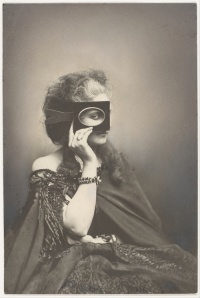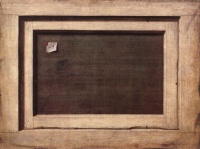Picture frame
From The Art and Popular Culture Encyclopedia


|
Related e |
|
Featured: |
A picture frame is a container for a picture, such as a painting or photograph, intended to enhance it, make it easier to display, or protect it.
Contents |
Construction
Picture frames have traditionally been made of wood, which is still the most common and most prestigious material, although other materials are also used, including aluminum, plastics or polystyrene, even sea shells. A picture frame may be of any colour or texture, but gilding is common, especially on older frames. Some picture frames have elaborate mouldings which may relate to the subject matter. Complicated older frames are often made of moulded and gilded plaster over a plain wood base.
The picture frame may contain a pane of glass or a plastic glass substitute such as Plexiglas, to protect the picture. In some instances where the art in the frame is dispensable or durable, no protection may be necessary. Glass is common over watercolours, rare over oil paintings, except very valuable ones in some museums. Glass may be treated with coatings, the most common being UV filters. Some glazings such as Denglas, Optium, and Museum glass have a coating which makes the glass partially nonreflective and practically invisible under ideal lighting conditions.
For pieces to be framed under glass, except for the most disposable and inexpensive posters or temporary displays, the glass must be raised off the surface of the paper. This is done by means of matting, a lining of plastic "spacers", shadowboxing, stacking two mouldings with the glass in between, and various other methods. If the paper (or other media) were to touch the glass directly, any condensation inside the glass would absorb directly into the art, having no room to evaporate. This is harmful to almost any medium. It causes art sticking to the glass, mildew, and other ill effects. Raising the glass is also necessary when a piece is done in a loose media such as charcoal or pastel, to prevent smudging. Care should be taken with these works, however, if Plexiglas is used as a static charge can build up which will attract the pigment particles off the paper. Using real glass helps to prevent this.
Certain kinds of pieces do not usually need glass when framed, including paintings done in acrylic or oil paint (the former is usually waterproof; the latter actually needs to "breathe" due to the decades-long drying process), stained glass or tiles, and laminated posters. These kinds of pieces are still sometimes put under glass though if for example, they are framed using mats, or (in the case of oil paintings) they are kept in a carefully climate-controlled environment.
The treatment of the back of the framed artwork varies widely, from usually nothing in the case of oils, to the frequent use of foam-core or backing paper or "dust covers" with watermedia. Usually paper will be inexpensive Kraft paper, but sometimes this can tear, so at least one website sells Black Tyvek as an alternative.
There is a U.S. Patent for a concealed compartment in a picture frame.
The frame along with its mounts should complement and project the artwork, art work framed incorrectly will not be shown to its full potential. However, this has exceptions as well, as Joan Miró once did a work specifically to frame with a flea market frame.
History
One of the earliest frame examples was a discovery made in an Egyptian tomb dating back to 2nd century A.D. in which a fayum mummy portrait was discovered at Hawara still within its wooden frame. This finding suggests the mummy portraits may have been hung in the owners' homes prior to inclusion within the funerary equipment. The portrait and its frame were most likely preserved by the desert climate, according to frame historian and installation expert Marilyn Murdoch explained in a historical talk to museum docents.
Although framing borders in ancient art were used to divide scenes and ornamentation by ancient Egyptian and Greek artists in pottery and wallpaintings, the first carved wooden frames as we know them today appeared on small panel paintings in twelfth and thirteenth century Europe.
When it was realized this method of producing a frame and the image within in one slab of wood was too costly, "a more efficient method was eventually developed which used mitered moulding strips. These strips were attached to a flat wooden panel which produced a similar result to the carved panel, but were more cost effective. This type of frame is known as an engaged frame. The early ones were made of simple wooden moulding strips attached to the outside edge of a wooden panel."
Throughout the 14th and 15th centuries, most European frames were church-commissioned and largely unmovable as they were altarpieces and a large part of the church's architecture. The frames were ornamented with architectural elements mimicking the exteriors of the great cathedrals. However the Renaissance of 14th and 15th century Italy saw the rise of arts patrons extending beyond the church. Wealthy nobles such as the Medici family could now bring art and frames into their estate by commissioning allegorical, devotional and portrait paintings. This was the advent of the portable or moveable frame.
Under the reign of Francis I, France's first Renaissance monarch from 1515 through 1547, art came to the forefront of daily life and flourished along with picture frames. Many workers came from Italy to partake in the arts trade, including Leonardo da Vinci, whom "Francis convinced to leave Italy in the last part of his life." Frames were now designed by furniture builders rather than the artist, sculptor or architect as in the past. Books on furniture and interior design were published and in distribution to a wider market than ever before.
From 1610 to 1643, under the reign of Louis XIII in France, the influence of court and refinement takes center stage in frame designs. The profiles became thinner than their Italian predecessors, and continuous design such as egg-and-dart, ribbon and flow of leaves, and pronounced low relief corner designs appear. This paves the way for Baroque design in picture framing.
Styles
"L"-style frames are a simple variety that are constructed with a single L-shaped border of wood, with the bottom part of the L, or rabbet, at the front of the frame to hold in the glass, object and backing, which are secured in from the back.
A photo cube is a special type of picture frame, often used to show members of a family, a vacation, or a timeline of someone's life.
Other styles are clip frames(not really a frame at all) , box frames and shadow boxes. A digital photo frame is an example of the changing technology of the 21st century.
Macaroni picture frames are a popular craft project for children. Uncooked pasta in various shapes are glued to a frame in a pattern. Sometimes the entire frame is painted.
See also
- Digital photo frame
- Gallery wrap
- Mat (picture framing)
- Fillet (picture framing)
- Gilding
- Gold leaf
- Silver leaf
- Diasec
- Fine Art Trade Guild

